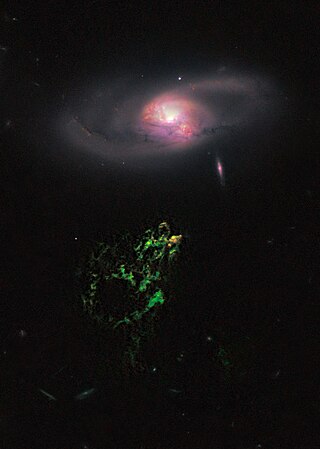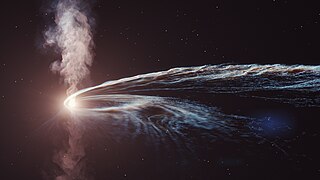Related Research Articles

In gamma-ray astronomy, gamma-ray bursts (GRBs) are immensely energetic explosions that have been observed in distant galaxies, described by NASA as "the most powerful class of explosions in the universe". They are the most energetic and luminous electromagnetic events since the Big Bang. Bursts can last from ten milliseconds to several hours. After an initial flash of gamma rays, a longer-lived "afterglow" is usually emitted at longer wavelengths.
An active galactic nucleus (AGN) is a compact region at the center of a galaxy that emits a significant amount of energy across the electromagnetic spectrum, with characteristics indicating that this luminosity is not produced by the stars. Such excess, non-stellar emissions have been observed in the radio, microwave, infrared, optical, ultra-violet, X-ray and gamma ray wavebands. A galaxy hosting an AGN is called an active galaxy. The non-stellar radiation from an AGN is theorized to result from the accretion of matter by a supermassive black hole at the center of its host galaxy.

Messier 87 is a supergiant elliptical galaxy in the constellation Virgo that contains several trillion stars. One of the largest and most massive galaxies in the local universe, it has a large population of globular clusters—about 15,000 compared with the 150–200 orbiting the Milky Way—and a jet of energetic plasma that originates at the core and extends at least 1,500 parsecs, traveling at a relativistic speed. It is one of the brightest radio sources in the sky and a popular target for both amateur and professional astronomers.

A supermassive black hole is the largest type of black hole, with its mass being on the order of hundreds of thousands, or millions to billions, of times the mass of the Sun (M☉). Black holes are a class of astronomical objects that have undergone gravitational collapse, leaving behind spheroidal regions of space from which nothing can escape, including light. Observational evidence indicates that almost every large galaxy has a supermassive black hole at its center. For example, the Milky Way galaxy has a supermassive black hole at its center, corresponding to the radio source Sagittarius A*. Accretion of interstellar gas onto supermassive black holes is the process responsible for powering active galactic nuclei (AGNs) and quasars.

Sagittarius A*, abbreviated Sgr A*, is the supermassive black hole at the Galactic Center of the Milky Way. Viewed from Earth, it is located near the border of the constellations Sagittarius and Scorpius, about 5.6° south of the ecliptic, visually close to the Butterfly Cluster (M6) and Lambda Scorpii.

An astrophysical jet is an astronomical phenomenon where outflows of ionised matter are emitted as extended beams along the axis of rotation. When this greatly accelerated matter in the beam approaches the speed of light, astrophysical jets become relativistic jets as they show effects from special relativity.

The IceCube Neutrino Observatory is a neutrino observatory constructed at the Amundsen–Scott South Pole Station in Antarctica. The project is a recognized CERN experiment (RE10). Its thousands of sensors are located under the Antarctic ice, distributed over a cubic kilometre.

NGC 5548 is a Type I Seyfert galaxy with a bright, active nucleus. This activity is caused by matter flowing onto a 65 million solar mass (M☉) supermassive black hole at the core. Morphologically, this is an unbarred lenticular galaxy with tightly-wound spiral arms, while shell and tidal tail features suggest that it has undergone a cosmologically-recent merger or interaction event. NGC 5548 is approximately 245 million light years away and appears in the constellation Boötes. The apparent visual magnitude of NGC 5548 is approximately 13.3 in the V band.

Abraham "Avi" Loeb is an Israeli-American theoretical physicist who works on astrophysics and cosmology. Loeb is the Frank B. Baird Jr. Professor of Science at Harvard University, where since 2007 he has been Director of the Institute for Theory and Computation at the Center for Astrophysics. He chaired the Department of Astronomy from 2011–2020, and founded the Black Hole Initiative in 2016.

Hanny's Voorwerp is a type of astronomical object called a quasar ionization echo. It was discovered in 2007 by Dutch schoolteacher Hanny van Arkel while she was participating as a volunteer in the Galaxy Zoo project, part of the Zooniverse group of citizen science websites. Photographically, it appears as a bright blob close to spiral galaxy IC 2497 in the constellation Leo Minor.

Swift J164449.3+573451, initially referred to as GRB 110328A, and sometimes abbreviated to Sw J1644+57, was a tidal disruption event (TDE), the destruction of a star by a supermassive black hole. It was first detected by the Swift Gamma-Ray Burst Mission on March 28, 2011. The event occurred in the center of a small galaxy in the Draco constellation, about 3.8 billion light-years away. It was the first confirmed jetted tidal disruption event and is the most luminous and energetic TDE recorded.
The Event Horizon Telescope (EHT) is a large telescope array consisting of a global network of radio telescopes. The EHT project combines data from several very-long-baseline interferometry (VLBI) stations around Earth, which form a combined array with an angular resolution sufficient to observe objects the size of a supermassive black hole's event horizon. The project's observational targets include the two black holes with the largest angular diameter as observed from Earth: the black hole at the center of the supergiant elliptical galaxy Messier 87, and Sagittarius A* at the center of the Milky Way.
Multi-messenger astronomy is astronomy based on the coordinated observation and interpretation of signals carried by disparate "messengers": electromagnetic radiation, gravitational waves, neutrinos, and cosmic rays. They are created by different astrophysical processes, and thus reveal different information about their sources.

A tidal disruption event (TDE) is a transient astronomical source produced when a star passes so close to a supermassive black hole (SMBH) that it is pulled apart by the black hole's tidal force. The star undergoes spaghettification, producing a tidal stream of material that loops around the black hole. Some portion of the stellar material is captured into orbit, forming an accretion disk around the black hole, which emits electromagnetic radiation. In a small fraction of TDEs, a relativistic jet is also produced. As the material in the disk is gradually consumed by the black hole, the TDE fades over several months or years.

TON 618 is a hyperluminous, broad-absorption-line, radio-loud quasar and Lyman-alpha blob located near the border of the constellations Canes Venatici and Coma Berenices, with the projected comoving distance of approximately 18.2 billion light-years from Earth. It possesses one of the most massive black holes ever found, at 40.7 billion M☉.

NGC 7469 is an intermediate spiral galaxy in the constellation of Pegasus. NGC 7469 is located about 200 million light-years away from Earth, which means, given its apparent dimensions, that NGC 7469 is approximately 90,000 light-years across. It was discovered by William Herschel on November 12, 1784.

NGC 7213 is a lenticular galaxy located in the constellation Grus. It is located at a distance of circa 70 million light-years from Earth, which, given its apparent dimensions, means that NGC 7213 is about 75,000 light-years across. It was discovered by John Herschel on September 30, 1834. It is an active galaxy with characteristics between a type I Seyfert galaxy and LINER.
ASASSN-19bt was a tidal disruption event (TDE) discovered by the All Sky Automated Survey for SuperNovae (ASAS-SN) project, with early-time, detailed observations by the TESS satellite. It was first detected on January 21, 2019, and reached peak brightness on March 4. The black hole which caused the TDE is in the 16th magnitude galaxy 2MASX J07001137-6602251 in the constellation Volans at a redshift of 0.0262, around 375 million light years away.

The Teacup galaxy, also known as the Teacup AGN or SDSS J1430+1339 is a low redshift type 2 quasar, showing an extended loop of ionized gas resembling a handle of a teacup, which was discovered by volunteers of the Galaxy Zoo project and labeled as a Voorwerpje.
AT2019qiz is a tidal disruption event (TDE) that occurred at a distance of 215 millions light years (65 megaparsec), from Earth. It is the nearest TDE discovered to date. It was discovered in September 2019 by observations in ultraviolet, optical, X-ray and radio wavelengths made at the European Southern Observatory (ESO) situated in Chile and was presented in October 2020 by research published in the monthly notices of the Royal Astronomical Society. It involves a star with a sun-like mass and a black hole with a mass of around 106 solar masses. The TDE appears very young and increasing in brightness. The encounter tore away half of the mass of the star and threw debris at a speed of 10,000 km/s, comparable to that observed in supernova explosions.
References
- 1 2 3 4 "AT 2018hyz | Transient Name Server". www.wis-tns.org.
- ↑ Cendes, Y.; Berger, E.; Alexander, K. D.; Gomez, S.; Hajela, A.; Chornock, R.; Laskar, T.; Margutti, R.; Metzger, B.; Bietenholz, M. F.; Brethauer, D.; Wieringa, M. H. (1 October 2022). "A Mildly Relativistic Outflow Launched Two Years after Disruption in Tidal Disruption Event AT2018hyz". The Astrophysical Journal. 938 (1): 28. arXiv: 2206.14297 . Bibcode:2022ApJ...938...28C. doi: 10.3847/1538-4357/ac88d0 .
- ↑ "'We've Never Seen Anything Like This Before:' Black Hole Spews Out Material Years After Shredding Star | Center for Astrophysics | Harvard & Smithsonian". www.cfa.harvard.edu. Retrieved 7 May 2024.
- ↑ Matsumoto, Tatsuya; Piran, Tsvi (2 May 2023). "Generalized equipartition method from an arbitrary viewing angle". Monthly Notices of the Royal Astronomical Society. 522 (3): 4565–4576. doi:10.1093/mnras/stad1269.


